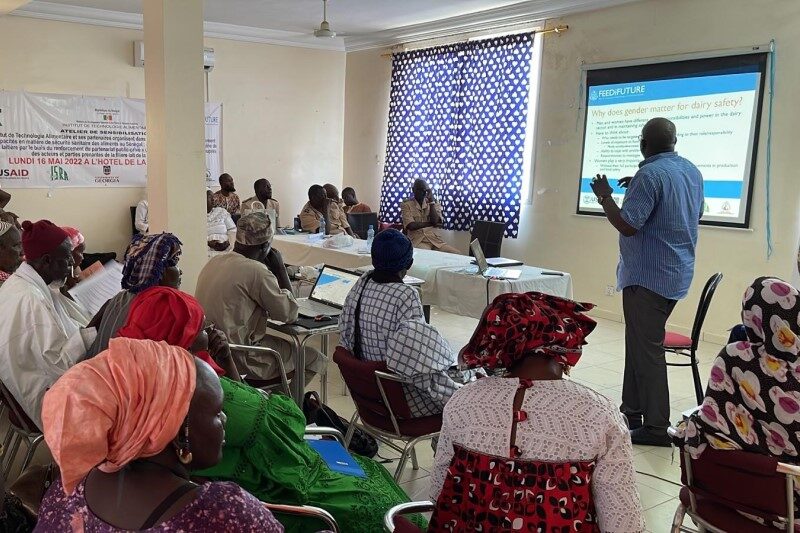
In late May, more than 40 dairy producers and processors gathered in Senegal’s Matam region, some having traveled up to 75 miles or with a child in tow. The participants, part of the country’s rapidly growing yet highly fragmented dairy supply chain, were attending a seminar on food safety fundamentals. It was one of three hosted in Senegal by a dairy safety project funded by the Feed the Future Innovation Lab for Food Safety.
“One of the female group leaders mentioned that they have had many trainings on making products, for example cheese and fermented milk, but this was the first focused on basic hygiene practices such as Good Management Practices and an introduction to sanitation,” said Manpreet Singh, project leader and department head and professor of food science and technology at the University of Georgia. “We adapted our presentations on the spot to make sure we were focusing on cleaning and sanitizing the equipment they have and using the hygiene principles to assure safety of the products that they’re making.”
Workshops were held in the St. Louis, Matam and Louga regions, engaging more than 100 participants in total. In keeping with the extensive participation of women in the dairy value chain, more than 90% of the workshop attendees were women. The workshops marked the first stakeholder outreach by the project, whose goal is to strengthen the safety of dairy and dairy products produced in Senegal. The Georgia-based researchers are partnering with Senegalese colleagues at the Senegalese Institute of Agricultural Research (ISRA), National Nutrition Development Council (CNDN) and Food Technology Institute (ITA) to strengthen local capacity for producing this nutrient-rich, economically important dietary staple.
“Dairy in general is a very perishable product; the shelf life inherently is not that long,” said Singh. “If we don’t implement interventions during processing, we know that dairy products will quickly deteriorate and become a potentially hazardous product due to microorganisms. The major outcome we hope for from this project is to have a safe dairy value chain in Senegal especially for the individual dairy farmers, with greater involvement from women and youth in the dairy value chain from a processed products perspective.”
Senegal’s supply chain of small farms, aggregation sites, artisanal processing facilities and transport from rural areas to urban centers creates challenges for protecting the microbial quality and safety of dairy products. The workshop addressed those challenges with an introduction to microbiology, sanitation and product and process controls, as well as a presentation on gender and youth in the dairy value chain. The focus was on immediate, practical knowledge.
“An attendee commented that the workshop was very informative and provided much needed training, including simple solutions that they can be more attentive to during milk collection and processing,” said Singh. He cited practices such as excluding milk from cows with mastitis, which can introduce a food safety risk, as well as consistent use of refrigeration at aggregation locations where milk is held before transport or processing.
In addition to offering the workshops, the team toured several dairy collection and processing facilities to recruit local partners for research and outreach. They visited mini-dairies and cheese making facilities, including the Mini-Laiterie de Boulal, a female-owned collection and milk pasteurization center. They also met with the Institut Supérieur d’Enseignement Professionnel (ISEP), a training institute which prepares youth to join Senegal’s agricultural workforce.
“From what we observed, the involvement of women in the dairy value chain is extensive, but the involvement of youth is not,” said co-principal investigators, Harshavardhan Thippareddi, the interim associate dean for research, and John Bekkers professor in poultry science at the University of Georgia. “So that’s one thing we will be considering — how to engage more people between the age of 15 and 35.”
Dialogue with stakeholders during the workshops and site visits brought into focus how economic constraints could impact food safety practices. Key technologies, such as refrigeration to slow microbial growth and pasteurization to destroy microbes that cause foodborne illness, not only require reliable access to energy but also increase the cost of production.
“Electricity is expensive. And it requires a financial buffer to pay for the repair or maintenance of food safety technologies or the solar panels to power them,” said Thippareddi. “Currently, some of the dairy producers are still early in their development as businesspeople — they may be extending the practices they used for home dairy production, and scaling up will require developing capacity for planning for contingencies.”
In the coming months, the project will be gathering baseline data on food safety risks in the dairy value chain, assessing which microbial pathogens are present and at what levels. The data will be key to understanding strategically where implementation of interventions could help mitigate food safety risks and informing data-driven food safety policies and practices.
“I think the project has an incredible opportunity to make an immediate impact on the milk production side in terms of hygiene during production,” said Thippareddi. “While we determine what the prevalence is and how to avoid specific problems like brucellosis, for immediate impact in these regions, we can build on these workshops with outreach activities on hygiene during the production side right away.”
Amanda Garris is a communications specialist with the Feed the Future Innovation Lab for Food Safety.

